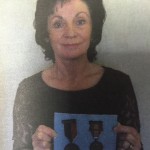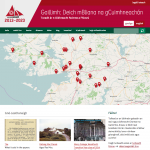As the national commemoration of 1916 reaches its pitch, one Galway woman offers a personal insight into a story that could be replicated by so man. Josephine Moran (née Higgins) lives in Cregboy, Claregalway and is formerly from Ballyheane, Castlebar.
Some time ago when finally sorting through my deceased mother’s things I came upon an old, slightly battered cardboard box.
It contained two medals wrapped in soft tissue. One bore the inscription, Seirbhís Náisiúnta Ré na Práinne An Fórsa Cosanta Áitiúil 1939–1946 hanging from a striped but faded red and white ribbon.
The other hung from a black and deep orange ribbon bearing an imprint of an armed soldier and simply read Éire, Cogadh na Saoirse.
My mind was cast back years to a time I had come across these medals once before and questioned my mother Kathleen with youthful vigour.
She had told me then that my deceased father, Michael Higgins, was the officer in charge of the local Defence forces during WWII or The Emergency as it was known in neutral Ireland in Ballyheane where I grew up with two brothers and two sisters, Monica, Eileen, Jim and Pat Higgins.
The other medal was more intriguing as my mother insisted this was the important one!
It was presented to my father as he was active in the Old IRA during the War of Independence. Seemingly he didn’t take up arms on account of his youth but served as a runner, bearing messages between different IRA cells often at great risk with the West Mayo Brigade.
Both he and his brothers and uncle Pat Higgins were known as athletes and hurlers at the time so this would account for his role.
He had been educated in St Jarlath’s College, Tuam, where he had first learned the skill of hurling which he duly passed on by forming and captaining the Ballyheane Hurling Team in 1925.
Michael Higgins was born in 1903 at a time when Ireland was ruled and occupied by Great Britain.
The executions of the leaders of the 1916 Rising in Dublin ignited the flame of patriotism and Irish men and women began to seek political and economic liberty in earnest.
However it was impossible to take on the might of the British Empire as the Irish were largely poor after 700 years of oppression an famines. They lacked weaponry and training.
So other means of achieving independence were sought – and one such method involved the burning of the then vacant RIC barracks in case the British reoccupied them to stockpile their arsenal.
Michael Higgins along with other local IRA members burned down the Ballyheane RIC barracks in 1920 on orders given by GHQ Dublin. He was only about 17 years of age.
Afterwards he fled to the hayfield he had been working on his uncle Pat’s farm in Magheranagay to avoid arrest. They knew the Castlebar RIC patrol backed up by the Black and Tans would come to investigate.
Michael Higgins’ uncle was Parish Priest of Castlebar and Auxillary Bishop of Tuam from 1912 until his untimely death in the Parochial House, Castlebar in 1918.
The medal bearing the inscription Seirbhís Náisiúnta Ré na Práinne An Fórsa Cosanta áitiúil 1939–1946 (Local FCA The Emergency Period) hangs from a single white striped ribbon on a red background.
During WWII of The Emergency as it was known here it was necessary to defend the homeland. The FAC was set up as a part-time force to take the place of the regular army as required.
My father, Michael Higgins, was the officer in charge of the local battalion in Ballyheane.
- Josephine Moran
- Josephine’s parents Michael and Kathleen Higgins







